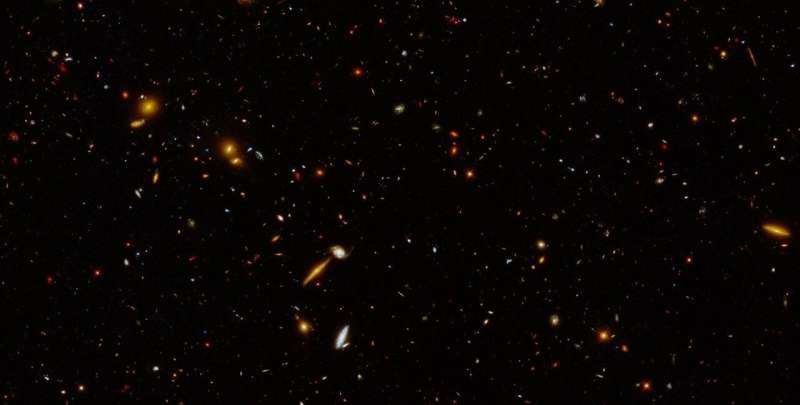Thousands of galaxies shine in ultraviolet light in new Hubble image

A new image from NASA’s Hubble Space Telescope is brimming with distant galaxies in an assortment of shapes. Some are seen face-on and appear oval or as disks or spirals, while others are seen edge-on and look more like cigars. The new image differs from past views of the same field of galaxies in that it now includes observations made in ultraviolet light.
“Ultraviolet light comes from the most massive stars, which are also the youngest and hottest of stars, and it provides a unique insight into ongoing star formation in galaxies both near and far,” says Xin Wang, a postdoctoral scholar at Caltech’s IPAC, an astronomy center. Wang presented the results June 14 at the 240th meeting of the American Astronomical Society (AAS) in Pasadena.
Wang and his colleagues, led by Harry Teplitz, a staff scientist at IPAC, used the Hubble Space Telescope to survey ultraviolet light coming from distant galaxies in a collection of different patches of sky known collectively as CANDELS, for Cosmic Assembly Near-infrared Deep Extragalactic Legacy Survey. They surveyed a large portion of the CANDELS fields, covering an amount of sky equivalent to about 60 percent the size of the full moon. In total, the new program, called UVCANDELS, imaged about 140,000 galaxies and amounted to about 10 days of Hubble time.
The result is the largest ultraviolet Hubble survey of distant galaxies to date. The researchers say the images will ultimately help with a mystery dating back to the early chapters of our universe, to an epoch known as reionization. This is when extreme, or high-energy, ultraviolet light from the first stars and galaxies ionized a fog of hydrogen gas, splitting atoms into charged electrons and protons. After the fog burned away, light could travel through the universe unimpeded, bringing an end to the so-called dark ages. Exactly how this happened is not clear, but by studying the extreme ultraviolet light emitted by distant galaxies, scientists will gather new clues.
“We can’t see the extreme ultraviolet light coming from the first galaxies because those photons are absorbed before they reach us,” says Teplitz. “We look instead at very similar, or analogous, galaxies that are not quite as far away—11 billion light-years instead of more than 13 billion—to try to understand the physical conditions that enabled the first galaxies to cause reionization.”
Additional details about Hubble can be found at the mission’s website
Citation:
Thousands of galaxies shine in ultraviolet light in new Hubble image (2022, June 14)
retrieved 14 June 2022
from https://phys.org/news/2022-06-thousands-galaxies-ultraviolet-hubble-image.html
This document is subject to copyright. Apart from any fair dealing for the purpose of private study or research, no
part may be reproduced without the written permission. The content is provided for information purposes only.
For all the latest Science News Click Here
For the latest news and updates, follow us on Google News.

